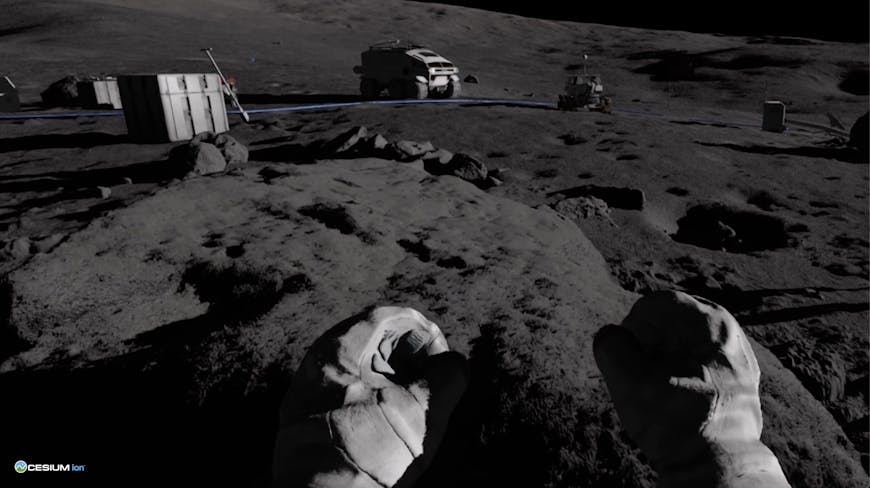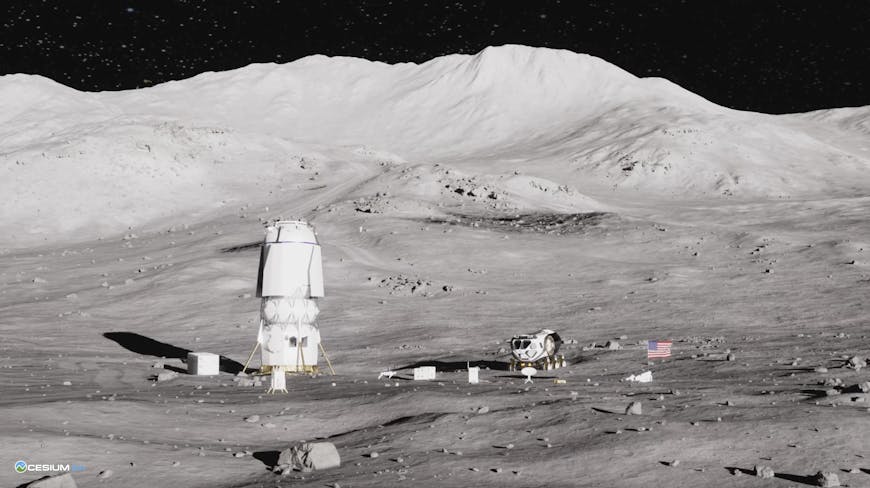Buendea Supports NASA Advanced Operations Concepts Lab with Cesium Moon Terrain
NASA calls the Moon “a treasure trove of science.” Buendea uses Cesium Moon Terrain to support NASA’s Advanced Operations Concepts Lab (NAOCL), ensuring astronauts’ virtual training accurately reflects the lunar environments they’ll encounter when they leave home.
Cesium Moon Terrain in XOSS supporting NASA’s Advanced Operations Concepts Lab. Courtesy Buendea and NAOCL.
Scientific discovery around life off Earth—rock samples and water, for example—will require specific tools and training. XR Operations Support System (XOSS) is a collaboration between Buendea and NAOCL, based out of Johnson Space Center (JSC) in Houston, Texas, USA, to train astronauts in an accurate 3D lunar environment.
XOSS users have the entire Moon in their simulation and can further immerse themselves in nine potential landing and habitation sites near the lunar South Pole, where Cesium Moon Terrain has its highest resolution data and Buendea has added additional high-res surface data. In VR mode, astronauts learn to board rovers, use tools to repair equipment, and work together. Admins running the sessions can trigger equipment failures or weather events to provide safe, repeatable learning experiences.
Buendea and NAOCL provide XOSS for other facilities to work with as a tool to integrate into their workflows for training and simulation. NASA Assessments of Physiology in Cognition for Hybrid Reality Environments (APACHE) carries out human performance studies using XOSS to prepare astronauts for traverses on the Moon, measuring biometric data and other outputs from these moonwalks. Crew Health and Performance Exploration Analog (CHAPEA) and Human Exploration Research Analog (HERA) are both habitat environments at JSC that use XOSS to carry out analog simulated activities for Moon and Mars surface operations. Other groups use XOSS as a digital twin to carry out ad-hoc or science activities for extravehicular activity and intravehicular activity (EVA/IVA).
Buendea was an early adopter of Cesium Moon Terrain and has used this geospatial base since its August 2024 release.

XOSS in VR mode. Courtesy Buendea and NAOCL.
Buendea founder Julian Reyes shared that the requirement from NASA was a platform that would deliver the entirety of the Moon in Unreal Engine. Reyes and his team were prepared to build a model of the Moon themselves. Today, XOSS accesses Cesium Moon Terrain via Cesium ion and Cesium for Unreal.
“By integrating Cesium Moon Terrain into our Unreal XOSS project, we were able to stand up our base integration of the lunar deployment instantly. This enabled us to start with developing and adding in our high-resolution surface terrain tiles directly into the deployment—and effectively cut our development time by more than 50%,” said Reyes, who will present XOSS at the 2025 Cesium Developer Conference.
Cesium Moon Terrain is the first complete, accurate, and readily accessible 3D dataset of the Moon. Served as 3D Tiles via Cesium ion, it enables visualization, simulation, and analysis for advanced digital twin creation.
XOSS currently accesses Cesium Moon Terrain via Cesium ion SaaS. In the near future, the platform will run internally at NASA via Cesium ion Self-Hosted to meet strict security requirements and enable a common workspace as more prototyping is done within XOSS. Buendea connects Cesium ion to its Unreal Engine projects via the open source Cesium for Unreal plugin, pulling in real-world content so astronauts learn among the terrain they expect to see.
With an accurate lunar base already deployed, Buendea’s developers have been able to focus their time on incorporating additional surface data, including topographic images from the Lunar Orbiter Laser Altimeter (LOLA) and photogrammetry of sample rocks from the Apollo missions; adding accurate physics for dispersing regolith on moon when driving; integrating AI for robotics support and geological identification; and modifying lighting to accurately reflect the elongated shadows the lunar South Pole experiences. Fusing graphics capabilities and validated data from many sources in one platform means collaborating groups get a comprehensive view and can prototype and design within XOSS, all on top of Cesium Moon Terrain.

XOSS users can immerse themselves in nine potential landing and habitation sites near the lunar South Pole. Courtesy Buendea and NAOCL.
Buendea plans to deploy XOSS internally at NASA, among commercial partners, and publicly, for open community development toward our shared future of human spaceflight.
Both Buendea and Cesium are at the 40th Space Symposium in Colorado Springs this week, April 7-10, 2025. Meet us in booth #628.
To add Cesium Moon Terrain to your Cesium for Unreal projects, follow this guide.